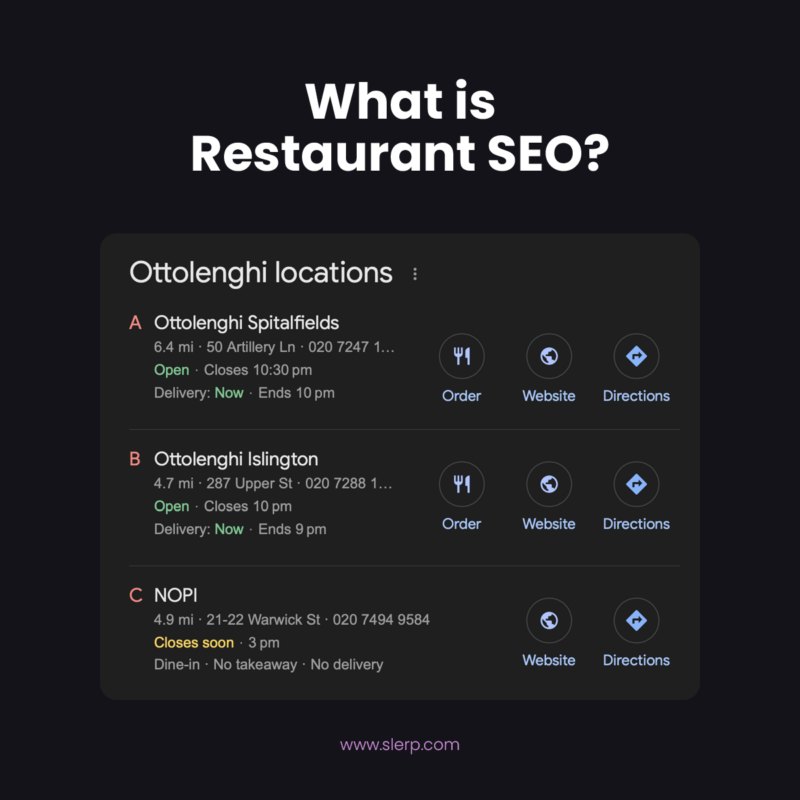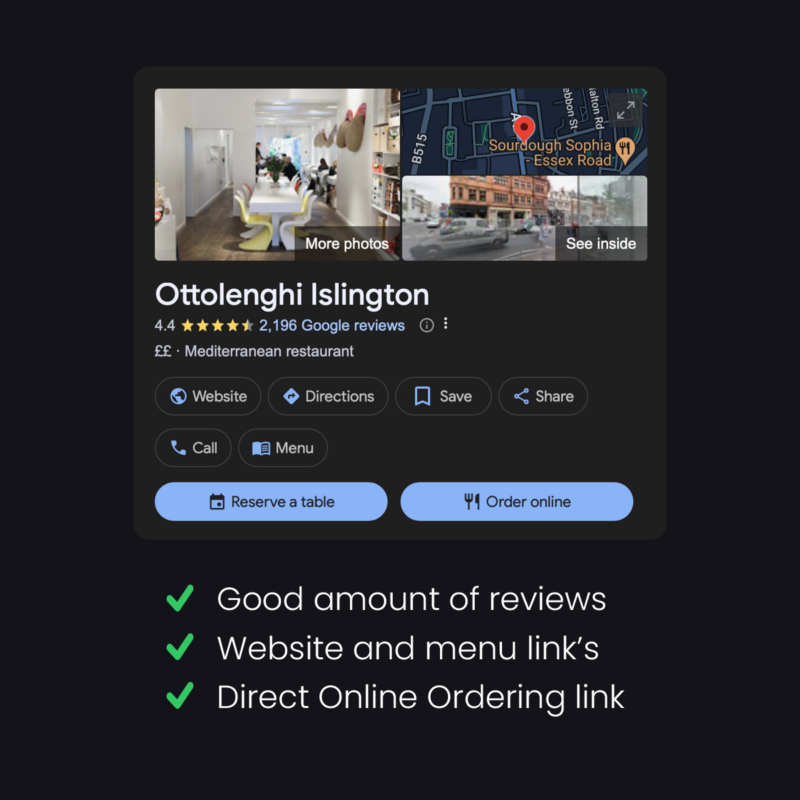Why restaurant SEO matters more than ever
In the fast-paced world of dining, being seen and chosen by customers online can make or break a restaurant. Google Search is the number one driver of new customers, surpassing traditional marketing methods like social media, flyers, or billboards. Yet, many restaurant owners are overwhelmed by the complexity of search engine optimization (SEO). The good news? Optimising your restaurant’s online presence is easier than you think and doesn’t require a tech-savvy background.
In this guide, we’ll break down the essential strategies to skyrocket your restaurant’s visibility on Google, leading to more reservations, takeout orders, and foot traffic.
Understanding restaurant SEO
Restaurant SEO is the practice of optimising your website to rank higher in local search results. When someone searches for “best pizza in London,” effective SEO ensures your restaurant appears at the top. This visibility translates to more clicks, more traffic, and ultimately, more customers. Whether you’re looking to increase online orders or boost in-house dining, mastering SEO is crucial for your restaurant’s success.
The 3 big wins for restaurant SEO
Big win #1: Perfect your Google Business Profile
Your Google Business Profile (GBP) is the cornerstone of local SEO. It’s often the first thing potential customers see when searching for restaurants nearby. Here’s how to make your GBP shine:
- Accurate Contact Information: Ensure your restaurant’s name, address, and phone number are consistent across all online platforms. Google rewards consistency, boosting your visibility.
- High-Quality Photos: Upload clear images of your restaurant’s interior and popular dishes. These don’t need to be professional shots but should be well-lit and inviting.
- Detailed Attributes: List all relevant attributes such as delivery options, parking availability, and dietary accommodations. This information helps Google match your profile with user searches.
- Comprehensive Menu: Include your menu directly in your GBP. This allows potential customers to quickly see what you offer, increasing the chances they’ll choose your restaurant.
- Encourage Google Reviews: Prompt satisfied customers to leave positive reviews on Google. High ratings and recent reviews significantly impact your search rankings.
Big win #2: Optimise your homepage with local cuisine keywords
To further enhance your online presence, sprinkle local and cuisine-specific keywords throughout your homepage. This strategy ensures your restaurant appears in searches for specific dishes or cuisines in your area.
For example, if you own an Italian restaurant in Manchester, phrases like “best pasta in Manchester” should be prominently featured. Here’s a quick guide:
- Title Tag: Incorporate your main keyword here, e.g., “Best Italian Restaurant in Manchester.”
- Header (H1) Tag: Use a descriptive headline, such as “Authentic Italian Cuisine in the Heart of Manchester”
- Body Text: Naturally include relevant keywords, like “enjoy our famous lasagna, freshly made in Manchester.”
Big Win #3: Enhance User Experience with Key Website Features
Google rewards websites that offer a seamless user experience. Make sure your site includes the following features to keep visitors engaged and signal quality to Google:
- Online reservations: Facilitate easy bookings directly from your website using tools like OpenTable or Resy.
- Online ordering: Offer direct online ordering on your site rather than redirecting to third-party platforms. This not only keeps users on your page longer but also increases your sales without hefty commission fees.
- Mobile-friendly design: Ensure your website is optimised for mobile devices. A significant portion of users will access your site from their phones, and a poor mobile experience can lead to high bounce rates.
Avoid these common SEO mistakes
To maximise your SEO efforts, steer clear of these frequent pitfalls:
- Off-site ordering links: Linking to external sites like Deliveroo for online orders can hurt your SEO. Keep users on your domain to boost engagement metrics and signal to Google that your site is valuable.
- Slow loading pages: Large images and videos can slow down your site, leading to higher bounce rates. Use tools like TinyPNG to compress images and limit video content to ensure fast loading times.
- PDF or image-based menus: Menus in PDF or image formats are hard to navigate on mobile and aren’t searchable by Google. Use text-based menus to improve readability and search ability.
Advanced SEO tips for restaurant websites
Once you’ve mastered the basics, these advanced tactics can further elevate your SEO game:
-
Build quality backlinks
Backlinks from reputable sites act as endorsements for your restaurant. The more high-quality backlinks you have, the more Google trusts your site, improving your rankings.
- Local Directories and Review Sites: List your restaurant on local directories and community sites to gain valuable backlinks.
- Collaborate with Food Bloggers: Reach out to local bloggers and food critics with unique stories or promotions to encourage them to feature your restaurant.
- Engage with Local Media: Participate in community events or collaborate with other businesses to create newsworthy content that can be picked up by local media.
-
Use alt text for images
Alt text describes your images to search engines, enhancing your site’s SEO. For example, a photo of your signature dish could have alt text like “delicious spaghetti carbonara at [Restaurant Name].” This makes your images searchable and reinforces your content with relevant keywords.
-
Expand your website with additional pages
A single-page website limits the information Google can use to rank you. Expand your site with additional pages to cover more topics and improve your visibility:
- About Us: Share your restaurant’s story and what makes it unique.
- Menu: List your menu items in text form for better readability and search ability.
- Delivery Areas: Specify the areas you deliver to, which helps capture local search traffic.
Start improving your SEO today
SEO is your restaurant’s best bet for attracting new customers and driving sales. With the strategies outlined in this guide, you can improve your online visibility without needing a developer or a marketing agency. Start implementing these tips today, and watch as more customers find and choose your restaurant.
SEO checklist recap:
- Optimise your Google Business Profile.
- Use local and cuisine-specific keywords.
- Enhance user experience with key website features.
- Avoid linking to external ordering platforms.
- Ensure fast page loading speeds.
- Convert PDF menus to text.
- Build backlinks from reputable sites.
- Add alt text to images.
- Expand your website with additional pages.
Remember, the sooner you start, the sooner you’ll see results. Don’t let your competitors get ahead—enhance your restaurant’s SEO today! Get started.



